10 reasons why students should build a personal brand




So, you're a student and you're wondering why you should start building a personal brand? Isn’t LinkedIn a place for older professionals? People with important sounding job titles? Nope!
If you asked your favourite content creator what their biggest regret is, chances are they’d tell you that they wished they’d started earlier. For LinkedIn, it’s the same story.
If you're a student, LinkedIn is the perfect place for you to talk about things you learn, document your journey as a student and show your work ethic and initiative! By building a personal brand while you’re a student you are going to shine and stand out amongst the crowd of millions of other students who are not doing the same. And when you want to work, jobs will find you instead of the other way around.
So, let's start with defining what is an online personal brand?
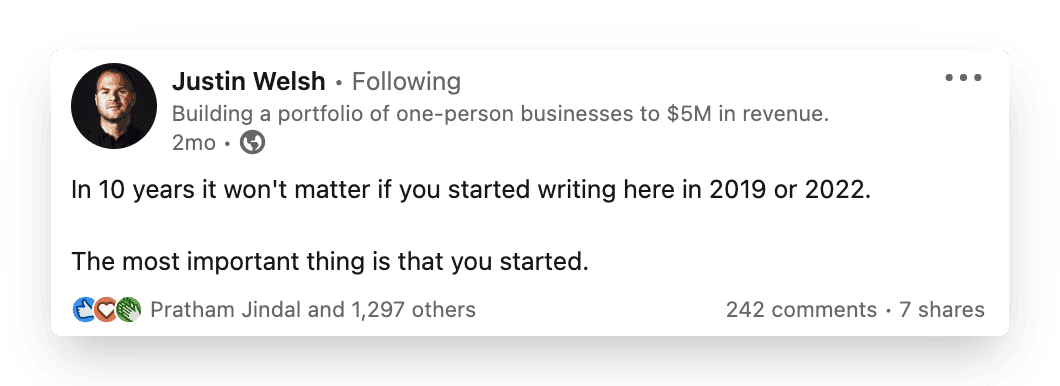
In essence, a personal brand is your digital identity and reputation. Through carefully thought-out posting, you can use it to build an audience and, if you play your cards right, land your dream job.
Here are our top 10 reasons to build a personal brand on LinkedIn.
1. Build an evolving CV
It's 2022 – applications need to be personable, and clicking ‘Apply’ on a company website with a one-page templatized CV simply won’t make you stand out.
Enter LinkedIn. These days, one of the first things a recruiter does when they receive a job application is to check the applicant's profile on LinkedIn. Now that is a great opportunity! When you create content, you control how you show up and how you are perceived.
LinkedIn allows you to continually edit and personalize your profile for people to discover.
From listing your work experience to adding skills, qualifications, and recommendations, your LinkedIn profile quickly becomes an ever-evolving all-in-one stop for employers to view your accomplishments and relevancy for a given role.
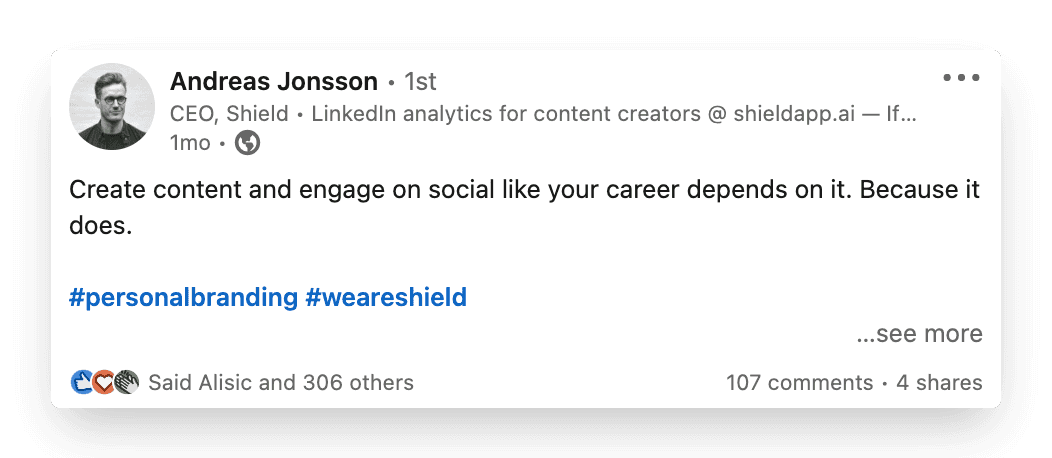
2. Attract recruiters and jobs to you
Let's look at a scenario – Jonathan and Bianca are both set to graduate from university this year. Both are set to achieve good grades, and both have had relevant work experience in their field.
Unlike Jonathan however, Bianca has been active on LinkedIn throughout the past year, writing about her Finance degree – what she’s learned and what she’s interested in. Through her posting, she’s struck up conversations with people already in the Finance industry, gaining insight into the employment process and what employers are looking for. By the time she starts applying for entry-level roles, she’s already on a few recruiters’ radar.
With this in mind, take 10 minutes to sit down and scroll through your feed. What are people in your industry talking about? What are common issues that pop up? What can you add to the conversation?
Here’s a great post example from Lubna Malhotra:
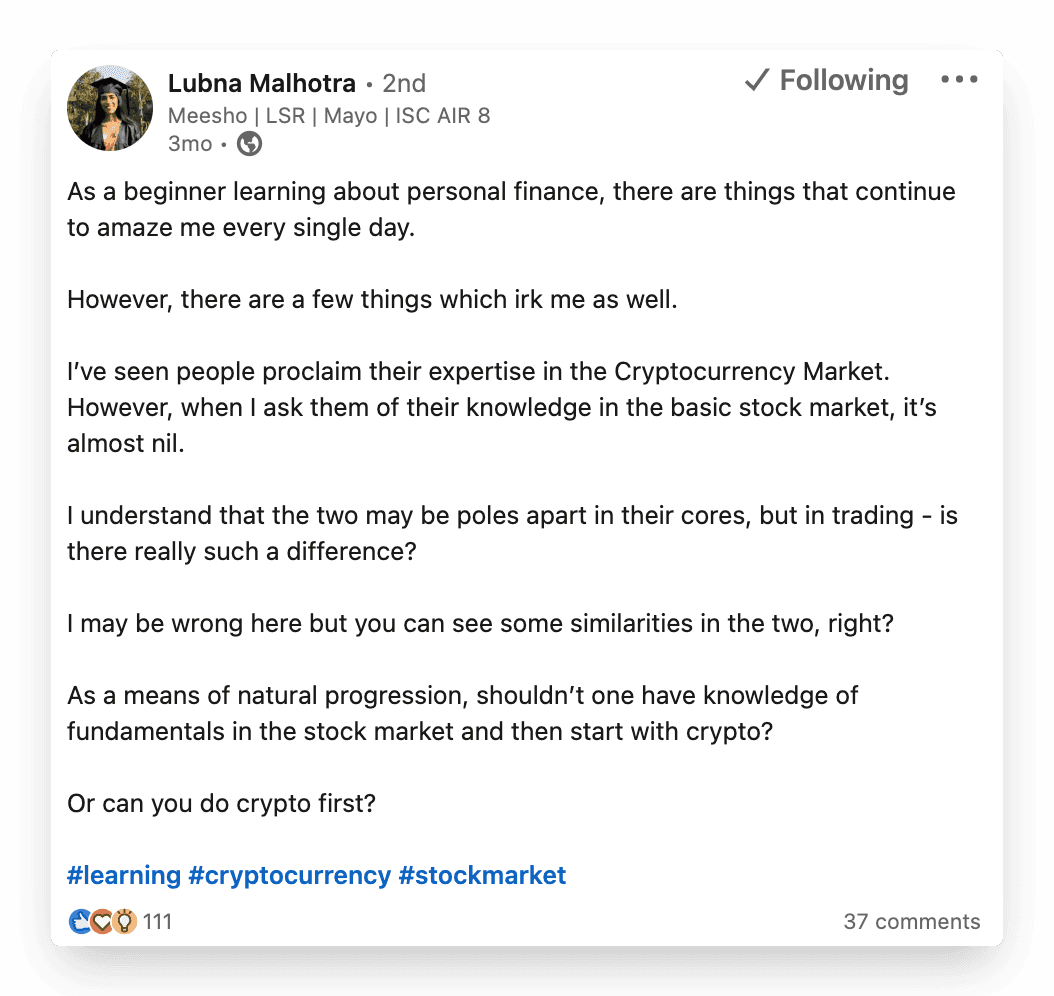
The above post is personable and demonstrates Lubna’s knowledge and learning around personal finance. Even better, it’s started a conversation around her chosen topic, as evidenced by the active comments section!
3. Learn how to market yourself
One of the main blockers students or young people often encounter when applying for entry-level positions is a lack of confidence – about their chosen industry as a whole and their place in it.
Here’s where posting on LinkedIn can be helpful as a platform to discuss your education and work experiences, allowing you to openly address your achievements and failures, and break out of your shell.
For example, see Tommaso’s post below:
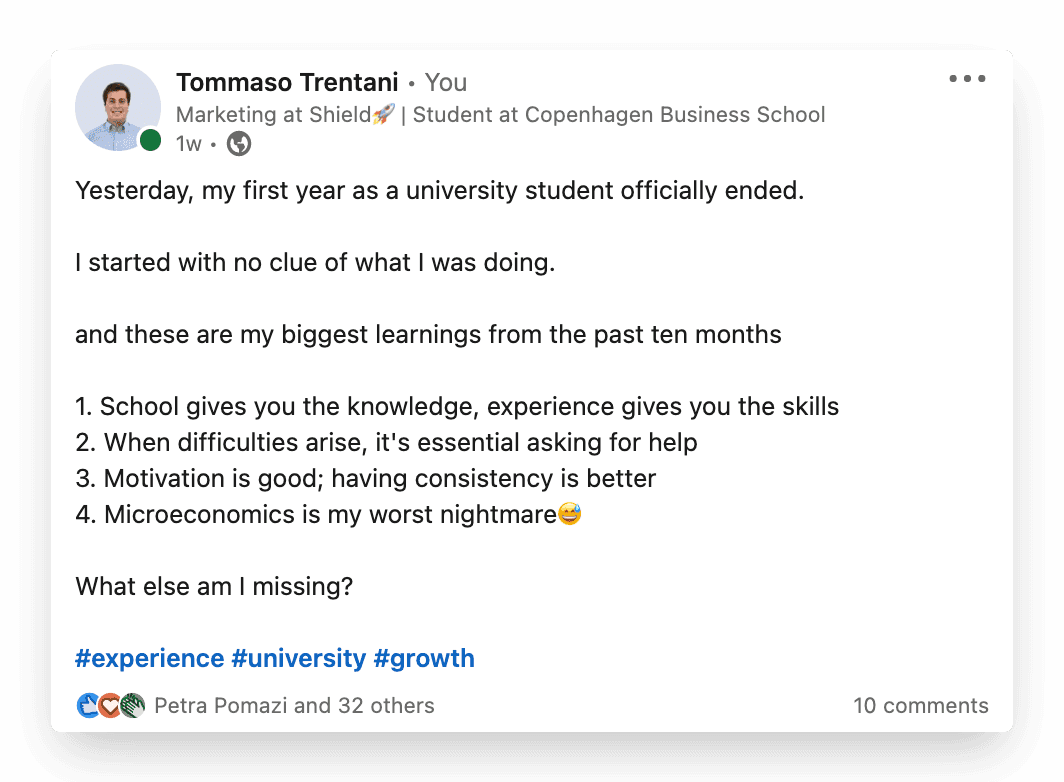
To recreate this post-type, break down a topic - for example, ‘7 mistakes I made as a first-year university student’. Create a list of key takeaways, and start writing. The key is to keep your posts short and sharp, and not overthink the writing process. For more guidance on how to write a scroll-stopping post, check out our blog post on the topic here!
You can also interact with your audience through post comments, improving your interpersonal skills in the process and gaining further insight into your field.
All in all, it’s a great way to dip your toes into the water and build your confidence.
4. Stand out amongst the sea of other students
Every year there are millions of students entering the job market, with an average of 118 applicants per job posting. That’s a big number.
That's where building a LinkedIn brand helps you stand out:
You can personalise your profile with professional photos and cover images.
You can showcase achievements and relevant posts in your ‘Featured’ section.
You can highlight key skills, and have endorsements visible on your profile.
That's just the start, go through the ultimate guide for setting up a perfect LinkedIn profile and let stand out from the crowd.

5. Connect with students around the globe
LinkedIn offers you the chance to connect with people across the globe – don’t waste this opportunity by only connecting with students in your class.
Instead, interact with students from different cities, countries, and continents – gain insights about your chosen field from a variety of angles. This is not just great to learn new things and to stay in the know about your chosen field but it's also a great opportunity to build a wide network of friends across the globe.
A great next step after a first few chats could be to jump on video calls with people you add to your network, this further cements the relationship and gives you opportunities to create content on LinkedIn and share learnings from your conversations.
6. Get noticed by your favourite companies
As a student it's a great idea to create a list of dream companies and people to work with. Find the company on LinkedIn and some people from that company who are active on LinkedIn.
Be sure to keep an eye on your favourite companies. What sort of content do they post? How often do they post?
Start with targeted engagement – commenting and interacting with their posts. Become an active audience voice and get noticed. You’ll get the opportunity to interact not just with that person but you'll most likely find more employees within the comment threads. This will create familiarity with your potential hiring managers and if a vacancy opens up, you’ll have a track record of being active and interested.
Remember to comment thoughtfully. Take this as each comment as an opportunity to show your curiosity and genuine interest in what the author of the content has to say.
Another great tactic is to follow the company page on LinkedIn and consistently engage with it with thoughtful comments. If it's a small company most likely someone in the marketing team will be managing that page. This gives you a foot in the door.
7. Connect with recruiters and managers
One key advantage LinkedIn offers over generic one-click CV applications is the ability to directly interact with managers and hiring professionals.
When you build your personal brand, be sure to engage with people working at the companies you are interested in. Ask them questions – What are they looking for in a specific role? What skills do they need to see?
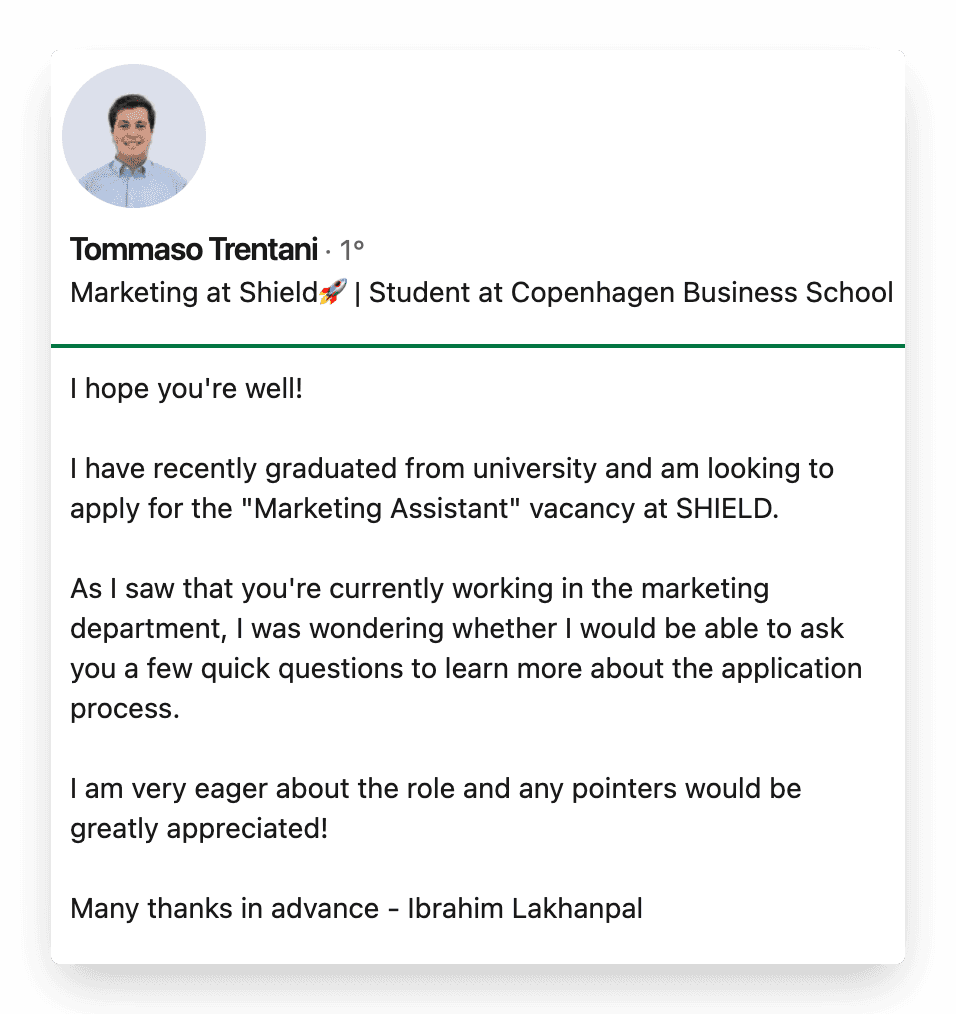
As a further step, whenever you see a job post, be sure to connect with the job poster and/or other people within that department.
Your name will pop up on their radar, and you’ll be able to ask questions about that specific vacancy, giving you an advantage over other applicants.
8. Exposure to industry insights
You can learn more about your chosen field through the profiles and posting habits of those within that industry. For example, if you’re interested in social media marketing, be sure to follow relevant accounts and keep a keen eye on their output. What are they saying about their roles? What insights are they providing?
It can become useful in understanding the nitty-gritty of jobs in your industry, as well as what’s expected on a day-to-day basis.
You may even find that the insights others provide make you reassess your career goals!
9. Know exactly when a job posting goes live
By setting up LinkedIn job alerts and using filters when searching for roles, job searching becomes a whole lot simpler.
Targeted networking also comes into play as your connections can refer you to different job postings via direct messaging! When you're connected to people in the company it's most likely that the recruiter might post about the opening and you can hear directly in your feed when a position goes live.
10. Backchannel networking
Connecting with people who have your dream job provides a great opportunity to get a behind-the-scenes look at your potential career future.
Once you engage with people and become a familiar face on their content you could also DM them with spefici questions. What advice can they give? How did they land your dream role? What skills do they value the most?
The more time you take to understand what got them there, the more you can implement their tips into your own LinkedIn content.
To conclude…
Hopefully, by now we’ve shown why LinkedIn is the all-in-one place to build a personal brand, apply for jobs, and set your career off on the right foot.
Here’s a look back at what we’ve covered:
Building an evolving CV
Attracting recruiters and jobs to you
Learning how to market yourself
Standing out amongst the sea of other students
Expanding your network, connecting with students around the globe
Getting noticed by your favorite companies
Connecting with recruiters and managers
Exposure to industry insights
Knowing exactly when a job posting goes live
Backchannel networking
Lead with your aspirations – follow companies that you’d want to be a part of and connect with people who have your dream job. Observe – What are they posting? What are they looking for? What skills do I need to feature on my profile? How can I match my profile to what they’re looking for?
Start here, and the rest is smooth sailing.
If you’re looking for a personal-branding wiz, be sure to take a look at our interview with LinkedIn guru Justin Welsh.
See you!
So, you're a student and you're wondering why you should start building a personal brand? Isn’t LinkedIn a place for older professionals? People with important sounding job titles? Nope!
If you asked your favourite content creator what their biggest regret is, chances are they’d tell you that they wished they’d started earlier. For LinkedIn, it’s the same story.
If you're a student, LinkedIn is the perfect place for you to talk about things you learn, document your journey as a student and show your work ethic and initiative! By building a personal brand while you’re a student you are going to shine and stand out amongst the crowd of millions of other students who are not doing the same. And when you want to work, jobs will find you instead of the other way around.
So, let's start with defining what is an online personal brand?

In essence, a personal brand is your digital identity and reputation. Through carefully thought-out posting, you can use it to build an audience and, if you play your cards right, land your dream job.
Here are our top 10 reasons to build a personal brand on LinkedIn.
1. Build an evolving CV
It's 2022 – applications need to be personable, and clicking ‘Apply’ on a company website with a one-page templatized CV simply won’t make you stand out.
Enter LinkedIn. These days, one of the first things a recruiter does when they receive a job application is to check the applicant's profile on LinkedIn. Now that is a great opportunity! When you create content, you control how you show up and how you are perceived.
LinkedIn allows you to continually edit and personalize your profile for people to discover.
From listing your work experience to adding skills, qualifications, and recommendations, your LinkedIn profile quickly becomes an ever-evolving all-in-one stop for employers to view your accomplishments and relevancy for a given role.

2. Attract recruiters and jobs to you
Let's look at a scenario – Jonathan and Bianca are both set to graduate from university this year. Both are set to achieve good grades, and both have had relevant work experience in their field.
Unlike Jonathan however, Bianca has been active on LinkedIn throughout the past year, writing about her Finance degree – what she’s learned and what she’s interested in. Through her posting, she’s struck up conversations with people already in the Finance industry, gaining insight into the employment process and what employers are looking for. By the time she starts applying for entry-level roles, she’s already on a few recruiters’ radar.
With this in mind, take 10 minutes to sit down and scroll through your feed. What are people in your industry talking about? What are common issues that pop up? What can you add to the conversation?
Here’s a great post example from Lubna Malhotra:

The above post is personable and demonstrates Lubna’s knowledge and learning around personal finance. Even better, it’s started a conversation around her chosen topic, as evidenced by the active comments section!
3. Learn how to market yourself
One of the main blockers students or young people often encounter when applying for entry-level positions is a lack of confidence – about their chosen industry as a whole and their place in it.
Here’s where posting on LinkedIn can be helpful as a platform to discuss your education and work experiences, allowing you to openly address your achievements and failures, and break out of your shell.
For example, see Tommaso’s post below:

To recreate this post-type, break down a topic - for example, ‘7 mistakes I made as a first-year university student’. Create a list of key takeaways, and start writing. The key is to keep your posts short and sharp, and not overthink the writing process. For more guidance on how to write a scroll-stopping post, check out our blog post on the topic here!
You can also interact with your audience through post comments, improving your interpersonal skills in the process and gaining further insight into your field.
All in all, it’s a great way to dip your toes into the water and build your confidence.
4. Stand out amongst the sea of other students
Every year there are millions of students entering the job market, with an average of 118 applicants per job posting. That’s a big number.
That's where building a LinkedIn brand helps you stand out:
You can personalise your profile with professional photos and cover images.
You can showcase achievements and relevant posts in your ‘Featured’ section.
You can highlight key skills, and have endorsements visible on your profile.
That's just the start, go through the ultimate guide for setting up a perfect LinkedIn profile and let stand out from the crowd.

5. Connect with students around the globe
LinkedIn offers you the chance to connect with people across the globe – don’t waste this opportunity by only connecting with students in your class.
Instead, interact with students from different cities, countries, and continents – gain insights about your chosen field from a variety of angles. This is not just great to learn new things and to stay in the know about your chosen field but it's also a great opportunity to build a wide network of friends across the globe.
A great next step after a first few chats could be to jump on video calls with people you add to your network, this further cements the relationship and gives you opportunities to create content on LinkedIn and share learnings from your conversations.
6. Get noticed by your favourite companies
As a student it's a great idea to create a list of dream companies and people to work with. Find the company on LinkedIn and some people from that company who are active on LinkedIn.
Be sure to keep an eye on your favourite companies. What sort of content do they post? How often do they post?
Start with targeted engagement – commenting and interacting with their posts. Become an active audience voice and get noticed. You’ll get the opportunity to interact not just with that person but you'll most likely find more employees within the comment threads. This will create familiarity with your potential hiring managers and if a vacancy opens up, you’ll have a track record of being active and interested.
Remember to comment thoughtfully. Take this as each comment as an opportunity to show your curiosity and genuine interest in what the author of the content has to say.
Another great tactic is to follow the company page on LinkedIn and consistently engage with it with thoughtful comments. If it's a small company most likely someone in the marketing team will be managing that page. This gives you a foot in the door.
7. Connect with recruiters and managers
One key advantage LinkedIn offers over generic one-click CV applications is the ability to directly interact with managers and hiring professionals.
When you build your personal brand, be sure to engage with people working at the companies you are interested in. Ask them questions – What are they looking for in a specific role? What skills do they need to see?

As a further step, whenever you see a job post, be sure to connect with the job poster and/or other people within that department.
Your name will pop up on their radar, and you’ll be able to ask questions about that specific vacancy, giving you an advantage over other applicants.
8. Exposure to industry insights
You can learn more about your chosen field through the profiles and posting habits of those within that industry. For example, if you’re interested in social media marketing, be sure to follow relevant accounts and keep a keen eye on their output. What are they saying about their roles? What insights are they providing?
It can become useful in understanding the nitty-gritty of jobs in your industry, as well as what’s expected on a day-to-day basis.
You may even find that the insights others provide make you reassess your career goals!
9. Know exactly when a job posting goes live
By setting up LinkedIn job alerts and using filters when searching for roles, job searching becomes a whole lot simpler.
Targeted networking also comes into play as your connections can refer you to different job postings via direct messaging! When you're connected to people in the company it's most likely that the recruiter might post about the opening and you can hear directly in your feed when a position goes live.
10. Backchannel networking
Connecting with people who have your dream job provides a great opportunity to get a behind-the-scenes look at your potential career future.
Once you engage with people and become a familiar face on their content you could also DM them with spefici questions. What advice can they give? How did they land your dream role? What skills do they value the most?
The more time you take to understand what got them there, the more you can implement their tips into your own LinkedIn content.
To conclude…
Hopefully, by now we’ve shown why LinkedIn is the all-in-one place to build a personal brand, apply for jobs, and set your career off on the right foot.
Here’s a look back at what we’ve covered:
Building an evolving CV
Attracting recruiters and jobs to you
Learning how to market yourself
Standing out amongst the sea of other students
Expanding your network, connecting with students around the globe
Getting noticed by your favorite companies
Connecting with recruiters and managers
Exposure to industry insights
Knowing exactly when a job posting goes live
Backchannel networking
Lead with your aspirations – follow companies that you’d want to be a part of and connect with people who have your dream job. Observe – What are they posting? What are they looking for? What skills do I need to feature on my profile? How can I match my profile to what they’re looking for?
Start here, and the rest is smooth sailing.
If you’re looking for a personal-branding wiz, be sure to take a look at our interview with LinkedIn guru Justin Welsh.
See you!
So, you're a student and you're wondering why you should start building a personal brand? Isn’t LinkedIn a place for older professionals? People with important sounding job titles? Nope!
If you asked your favourite content creator what their biggest regret is, chances are they’d tell you that they wished they’d started earlier. For LinkedIn, it’s the same story.
If you're a student, LinkedIn is the perfect place for you to talk about things you learn, document your journey as a student and show your work ethic and initiative! By building a personal brand while you’re a student you are going to shine and stand out amongst the crowd of millions of other students who are not doing the same. And when you want to work, jobs will find you instead of the other way around.
So, let's start with defining what is an online personal brand?

In essence, a personal brand is your digital identity and reputation. Through carefully thought-out posting, you can use it to build an audience and, if you play your cards right, land your dream job.
Here are our top 10 reasons to build a personal brand on LinkedIn.
1. Build an evolving CV
It's 2022 – applications need to be personable, and clicking ‘Apply’ on a company website with a one-page templatized CV simply won’t make you stand out.
Enter LinkedIn. These days, one of the first things a recruiter does when they receive a job application is to check the applicant's profile on LinkedIn. Now that is a great opportunity! When you create content, you control how you show up and how you are perceived.
LinkedIn allows you to continually edit and personalize your profile for people to discover.
From listing your work experience to adding skills, qualifications, and recommendations, your LinkedIn profile quickly becomes an ever-evolving all-in-one stop for employers to view your accomplishments and relevancy for a given role.

2. Attract recruiters and jobs to you
Let's look at a scenario – Jonathan and Bianca are both set to graduate from university this year. Both are set to achieve good grades, and both have had relevant work experience in their field.
Unlike Jonathan however, Bianca has been active on LinkedIn throughout the past year, writing about her Finance degree – what she’s learned and what she’s interested in. Through her posting, she’s struck up conversations with people already in the Finance industry, gaining insight into the employment process and what employers are looking for. By the time she starts applying for entry-level roles, she’s already on a few recruiters’ radar.
With this in mind, take 10 minutes to sit down and scroll through your feed. What are people in your industry talking about? What are common issues that pop up? What can you add to the conversation?
Here’s a great post example from Lubna Malhotra:

The above post is personable and demonstrates Lubna’s knowledge and learning around personal finance. Even better, it’s started a conversation around her chosen topic, as evidenced by the active comments section!
3. Learn how to market yourself
One of the main blockers students or young people often encounter when applying for entry-level positions is a lack of confidence – about their chosen industry as a whole and their place in it.
Here’s where posting on LinkedIn can be helpful as a platform to discuss your education and work experiences, allowing you to openly address your achievements and failures, and break out of your shell.
For example, see Tommaso’s post below:

To recreate this post-type, break down a topic - for example, ‘7 mistakes I made as a first-year university student’. Create a list of key takeaways, and start writing. The key is to keep your posts short and sharp, and not overthink the writing process. For more guidance on how to write a scroll-stopping post, check out our blog post on the topic here!
You can also interact with your audience through post comments, improving your interpersonal skills in the process and gaining further insight into your field.
All in all, it’s a great way to dip your toes into the water and build your confidence.
4. Stand out amongst the sea of other students
Every year there are millions of students entering the job market, with an average of 118 applicants per job posting. That’s a big number.
That's where building a LinkedIn brand helps you stand out:
You can personalise your profile with professional photos and cover images.
You can showcase achievements and relevant posts in your ‘Featured’ section.
You can highlight key skills, and have endorsements visible on your profile.
That's just the start, go through the ultimate guide for setting up a perfect LinkedIn profile and let stand out from the crowd.

5. Connect with students around the globe
LinkedIn offers you the chance to connect with people across the globe – don’t waste this opportunity by only connecting with students in your class.
Instead, interact with students from different cities, countries, and continents – gain insights about your chosen field from a variety of angles. This is not just great to learn new things and to stay in the know about your chosen field but it's also a great opportunity to build a wide network of friends across the globe.
A great next step after a first few chats could be to jump on video calls with people you add to your network, this further cements the relationship and gives you opportunities to create content on LinkedIn and share learnings from your conversations.
6. Get noticed by your favourite companies
As a student it's a great idea to create a list of dream companies and people to work with. Find the company on LinkedIn and some people from that company who are active on LinkedIn.
Be sure to keep an eye on your favourite companies. What sort of content do they post? How often do they post?
Start with targeted engagement – commenting and interacting with their posts. Become an active audience voice and get noticed. You’ll get the opportunity to interact not just with that person but you'll most likely find more employees within the comment threads. This will create familiarity with your potential hiring managers and if a vacancy opens up, you’ll have a track record of being active and interested.
Remember to comment thoughtfully. Take this as each comment as an opportunity to show your curiosity and genuine interest in what the author of the content has to say.
Another great tactic is to follow the company page on LinkedIn and consistently engage with it with thoughtful comments. If it's a small company most likely someone in the marketing team will be managing that page. This gives you a foot in the door.
7. Connect with recruiters and managers
One key advantage LinkedIn offers over generic one-click CV applications is the ability to directly interact with managers and hiring professionals.
When you build your personal brand, be sure to engage with people working at the companies you are interested in. Ask them questions – What are they looking for in a specific role? What skills do they need to see?

As a further step, whenever you see a job post, be sure to connect with the job poster and/or other people within that department.
Your name will pop up on their radar, and you’ll be able to ask questions about that specific vacancy, giving you an advantage over other applicants.
8. Exposure to industry insights
You can learn more about your chosen field through the profiles and posting habits of those within that industry. For example, if you’re interested in social media marketing, be sure to follow relevant accounts and keep a keen eye on their output. What are they saying about their roles? What insights are they providing?
It can become useful in understanding the nitty-gritty of jobs in your industry, as well as what’s expected on a day-to-day basis.
You may even find that the insights others provide make you reassess your career goals!
9. Know exactly when a job posting goes live
By setting up LinkedIn job alerts and using filters when searching for roles, job searching becomes a whole lot simpler.
Targeted networking also comes into play as your connections can refer you to different job postings via direct messaging! When you're connected to people in the company it's most likely that the recruiter might post about the opening and you can hear directly in your feed when a position goes live.
10. Backchannel networking
Connecting with people who have your dream job provides a great opportunity to get a behind-the-scenes look at your potential career future.
Once you engage with people and become a familiar face on their content you could also DM them with spefici questions. What advice can they give? How did they land your dream role? What skills do they value the most?
The more time you take to understand what got them there, the more you can implement their tips into your own LinkedIn content.
To conclude…
Hopefully, by now we’ve shown why LinkedIn is the all-in-one place to build a personal brand, apply for jobs, and set your career off on the right foot.
Here’s a look back at what we’ve covered:
Building an evolving CV
Attracting recruiters and jobs to you
Learning how to market yourself
Standing out amongst the sea of other students
Expanding your network, connecting with students around the globe
Getting noticed by your favorite companies
Connecting with recruiters and managers
Exposure to industry insights
Knowing exactly when a job posting goes live
Backchannel networking
Lead with your aspirations – follow companies that you’d want to be a part of and connect with people who have your dream job. Observe – What are they posting? What are they looking for? What skills do I need to feature on my profile? How can I match my profile to what they’re looking for?
Start here, and the rest is smooth sailing.
If you’re looking for a personal-branding wiz, be sure to take a look at our interview with LinkedIn guru Justin Welsh.
See you!
So, you're a student and you're wondering why you should start building a personal brand? Isn’t LinkedIn a place for older professionals? People with important sounding job titles? Nope!
If you asked your favourite content creator what their biggest regret is, chances are they’d tell you that they wished they’d started earlier. For LinkedIn, it’s the same story.
If you're a student, LinkedIn is the perfect place for you to talk about things you learn, document your journey as a student and show your work ethic and initiative! By building a personal brand while you’re a student you are going to shine and stand out amongst the crowd of millions of other students who are not doing the same. And when you want to work, jobs will find you instead of the other way around.
So, let's start with defining what is an online personal brand?

In essence, a personal brand is your digital identity and reputation. Through carefully thought-out posting, you can use it to build an audience and, if you play your cards right, land your dream job.
Here are our top 10 reasons to build a personal brand on LinkedIn.
1. Build an evolving CV
It's 2022 – applications need to be personable, and clicking ‘Apply’ on a company website with a one-page templatized CV simply won’t make you stand out.
Enter LinkedIn. These days, one of the first things a recruiter does when they receive a job application is to check the applicant's profile on LinkedIn. Now that is a great opportunity! When you create content, you control how you show up and how you are perceived.
LinkedIn allows you to continually edit and personalize your profile for people to discover.
From listing your work experience to adding skills, qualifications, and recommendations, your LinkedIn profile quickly becomes an ever-evolving all-in-one stop for employers to view your accomplishments and relevancy for a given role.

2. Attract recruiters and jobs to you
Let's look at a scenario – Jonathan and Bianca are both set to graduate from university this year. Both are set to achieve good grades, and both have had relevant work experience in their field.
Unlike Jonathan however, Bianca has been active on LinkedIn throughout the past year, writing about her Finance degree – what she’s learned and what she’s interested in. Through her posting, she’s struck up conversations with people already in the Finance industry, gaining insight into the employment process and what employers are looking for. By the time she starts applying for entry-level roles, she’s already on a few recruiters’ radar.
With this in mind, take 10 minutes to sit down and scroll through your feed. What are people in your industry talking about? What are common issues that pop up? What can you add to the conversation?
Here’s a great post example from Lubna Malhotra:

The above post is personable and demonstrates Lubna’s knowledge and learning around personal finance. Even better, it’s started a conversation around her chosen topic, as evidenced by the active comments section!
3. Learn how to market yourself
One of the main blockers students or young people often encounter when applying for entry-level positions is a lack of confidence – about their chosen industry as a whole and their place in it.
Here’s where posting on LinkedIn can be helpful as a platform to discuss your education and work experiences, allowing you to openly address your achievements and failures, and break out of your shell.
For example, see Tommaso’s post below:

To recreate this post-type, break down a topic - for example, ‘7 mistakes I made as a first-year university student’. Create a list of key takeaways, and start writing. The key is to keep your posts short and sharp, and not overthink the writing process. For more guidance on how to write a scroll-stopping post, check out our blog post on the topic here!
You can also interact with your audience through post comments, improving your interpersonal skills in the process and gaining further insight into your field.
All in all, it’s a great way to dip your toes into the water and build your confidence.
4. Stand out amongst the sea of other students
Every year there are millions of students entering the job market, with an average of 118 applicants per job posting. That’s a big number.
That's where building a LinkedIn brand helps you stand out:
You can personalise your profile with professional photos and cover images.
You can showcase achievements and relevant posts in your ‘Featured’ section.
You can highlight key skills, and have endorsements visible on your profile.
That's just the start, go through the ultimate guide for setting up a perfect LinkedIn profile and let stand out from the crowd.

5. Connect with students around the globe
LinkedIn offers you the chance to connect with people across the globe – don’t waste this opportunity by only connecting with students in your class.
Instead, interact with students from different cities, countries, and continents – gain insights about your chosen field from a variety of angles. This is not just great to learn new things and to stay in the know about your chosen field but it's also a great opportunity to build a wide network of friends across the globe.
A great next step after a first few chats could be to jump on video calls with people you add to your network, this further cements the relationship and gives you opportunities to create content on LinkedIn and share learnings from your conversations.
6. Get noticed by your favourite companies
As a student it's a great idea to create a list of dream companies and people to work with. Find the company on LinkedIn and some people from that company who are active on LinkedIn.
Be sure to keep an eye on your favourite companies. What sort of content do they post? How often do they post?
Start with targeted engagement – commenting and interacting with their posts. Become an active audience voice and get noticed. You’ll get the opportunity to interact not just with that person but you'll most likely find more employees within the comment threads. This will create familiarity with your potential hiring managers and if a vacancy opens up, you’ll have a track record of being active and interested.
Remember to comment thoughtfully. Take this as each comment as an opportunity to show your curiosity and genuine interest in what the author of the content has to say.
Another great tactic is to follow the company page on LinkedIn and consistently engage with it with thoughtful comments. If it's a small company most likely someone in the marketing team will be managing that page. This gives you a foot in the door.
7. Connect with recruiters and managers
One key advantage LinkedIn offers over generic one-click CV applications is the ability to directly interact with managers and hiring professionals.
When you build your personal brand, be sure to engage with people working at the companies you are interested in. Ask them questions – What are they looking for in a specific role? What skills do they need to see?

As a further step, whenever you see a job post, be sure to connect with the job poster and/or other people within that department.
Your name will pop up on their radar, and you’ll be able to ask questions about that specific vacancy, giving you an advantage over other applicants.
8. Exposure to industry insights
You can learn more about your chosen field through the profiles and posting habits of those within that industry. For example, if you’re interested in social media marketing, be sure to follow relevant accounts and keep a keen eye on their output. What are they saying about their roles? What insights are they providing?
It can become useful in understanding the nitty-gritty of jobs in your industry, as well as what’s expected on a day-to-day basis.
You may even find that the insights others provide make you reassess your career goals!
9. Know exactly when a job posting goes live
By setting up LinkedIn job alerts and using filters when searching for roles, job searching becomes a whole lot simpler.
Targeted networking also comes into play as your connections can refer you to different job postings via direct messaging! When you're connected to people in the company it's most likely that the recruiter might post about the opening and you can hear directly in your feed when a position goes live.
10. Backchannel networking
Connecting with people who have your dream job provides a great opportunity to get a behind-the-scenes look at your potential career future.
Once you engage with people and become a familiar face on their content you could also DM them with spefici questions. What advice can they give? How did they land your dream role? What skills do they value the most?
The more time you take to understand what got them there, the more you can implement their tips into your own LinkedIn content.
To conclude…
Hopefully, by now we’ve shown why LinkedIn is the all-in-one place to build a personal brand, apply for jobs, and set your career off on the right foot.
Here’s a look back at what we’ve covered:
Building an evolving CV
Attracting recruiters and jobs to you
Learning how to market yourself
Standing out amongst the sea of other students
Expanding your network, connecting with students around the globe
Getting noticed by your favorite companies
Connecting with recruiters and managers
Exposure to industry insights
Knowing exactly when a job posting goes live
Backchannel networking
Lead with your aspirations – follow companies that you’d want to be a part of and connect with people who have your dream job. Observe – What are they posting? What are they looking for? What skills do I need to feature on my profile? How can I match my profile to what they’re looking for?
Start here, and the rest is smooth sailing.
If you’re looking for a personal-branding wiz, be sure to take a look at our interview with LinkedIn guru Justin Welsh.
See you!


